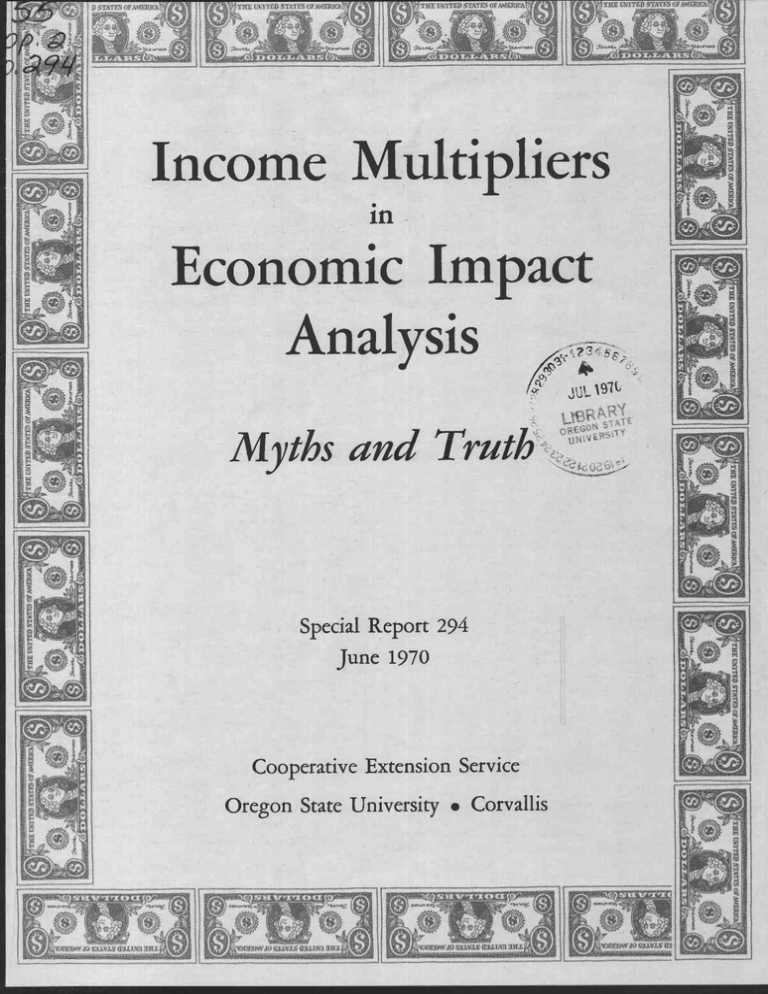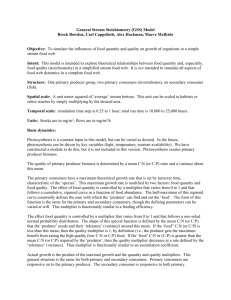Economic Impact Analysis ? Income Multipliers
advertisement

r/Te3 OTANTEKK Income Multipliers Economic Impact Analysis ? ■" WI i9lt „:,,,,,„5,1 Myths and Truth -„,.1.-VB R NR 0 REGON 57 kly Special Report 294 June 1970 Cooperative Extension Service Oregon State University • Corvallis V7111 .. ........... Income Multipliers in Economic Impact Analysis by Robert 0. Coppedge, Extension Agricultural Economist, and Russell C. Youmans, Extension Resource Economist A rough rule of thumb would be that the total economic impact of new money on income within a state is less than twice the original new income. A multiplier that exceeds 2 should be subjected to critical review before acceptance or use in further analysis. The Multiplier Concept The concept of a multiplier is illustrated by an example where $100 is invested in an area. A multiplier of 1.4 says that the total eutflomic impact on income will be $140, including the original $100. Uses of Multipliers The impact of an investment on a community or state is important to many people. The increased income is naturally important to those families who are affected. How much incomes are affected is important to planners as they endeavor to solve local or state economic problems. Different investments and different areas affect the size and distribution of the impact, and planners are thus helped in choosing between competing factors about where and what kinds of investments are appropriate. To better plan future development in light of local needs, planners benefit from knowing how many dollars will be available to demand new services. Tax bases are also affected by changes in income. Knowledge of the types of leakages in an area would help local developers, as they try to encourage people to spend locally. Some of the goods and services once available only from distant places may become available locally. Knowing the size of the multiplier and how it works can help people to both better estimate economic benefits and increase the size of the benefits. Flow of Water and Leakages Picture a desert. Hot, dusty, and dry—no rain for six months. Out of a distant mountain range flows a stream, from which farmers irrigate their crops, water their cattle, and wash their clothes—they may even drink it, but not necessarily in that order. The farmer struggles to use the water to the greatest benefit. There never seems to be enough. Evaporation takes a heavy toll, and leakages from the system claim much. All of the water eventually is used or passes through. If the farmer could control the water, he could receive much more benefit from it. But the point is the water flows freely and the irrigator cannot capture all of it. The thirsty land competes with a hot sun, which reduces the farmer's available water. Even if dams were built, leakages (both evaporation and seepage) would still take a heavy toll. Flow of Money and Leakages Moving this illustration into the economic realm of a state, we note that money flows freely in a healthy economy such as Oregon. The money also moves into other states who supply some of Oregon's needs and in turn buy much of Oregon's product. Imagine new money moving to Oregon—an investment being brought to the state for economic development. Or imagine expenditures for recreation and the purchase of agricultural goods or timber products, all representing new money to the state's economy. Someone asks "What is the impact of this development, or these purchases, on the economy of our state ?" The answer lies in the multiplier, which indicates the total impact on income or business activity in OUR STATE that results from this initial investment or expenditure. This concept is similar to "How much benefit can the farmer get from the water ?" Both questions depend upon how great the leakages (largely expenditures outside the state) are and how much benefit is realized before disappearance is total. Purchases outside the state are not bad. We cannot produce all that we need or desire within the state and it is to our economic advantage to trade our products and services for those produced elsewhere. MEASURING THE FLOW AND LEAKAGES Mythical Multipliers Myth 1 An industry takes one dollar of raw product, and by changing it to the form demanded by the homemaker, adds value through processing, transporting to a convenient purchase point, and having the finished product available when desired. The raw product ( food in this example) is brought in from the fields, transported to town, washed, inspected, graded, cooked, packaged, frozen, delivered to storage points and on to supermarkets, and eventually bought by the consumer. In this time the market has spent more money on the product improving and converting a dollar's worth of raw materials into a finished product. When the product is delivered at the proper time and place, a housewife pays eight dollars for all the services included in the finished good. Is this an income multiplier of 8 for Oregon's economy where one dollar created eight ? NO ! Myth 2 A report states that a dollar "turns over" six times in the economy after the initial purchase. This may be illustrated by following a purchase of some product or service in the state. A dollar is spent to buy some product. But the person selling the product has expenses accumulated before a sale is made. He has wages to pay, utility and rent bills on his establishment, and the original product cost him something to acquire. Upon the receipt of the dollar from the sale the seller pays his bills. He, hopefully, can retain some for his own disposable income. The original dollar is now broken into parts and distributed about the state, some of it may even have left the state in payment for goods and services. In like manner, the firms and individuals receiving the second-round impact from the dollar sale have bills to pay. The money is then further divided and scattered within the state and some again is lost in leakages outside the state. This process continues until we can no longer measure the impact of this one dollar sale. Let's suppose it took 6 rounds of bill payments to lose this dollar to leakages outside Oregon. Was this a state multiplier of 6? NO! Explanation of Myths The two measurements of economic activity are useful, but not multipliers. They do not directly measure economic impact on the state's income. Both examples contain valid economic concepts. The first is value-added—the increase in value resulting from doing something to or with the product. Each handler of the goods does something useful which makes the product more valuable. In measuring the relative economic importance of an industry, value-added is useful because it measures that industry's contribution to the gross product of the economy. The second example is of a turnover, which tells the average number of times a dollar changes hands as it is spent. But using this figure as the income multiplier ignores the fact that each time money turns over, the amount retained within the state is reduced. Leakages rapidly diminish the amount of each dollar retained in the state's economy. Unfortunately many economists (professional and otherwise) have used the value-added and turnover concepts loosely, often implying they represent multipliers. The myths and misunderstandings that have arisen in this respect have been unfortunate and in some cases painful. The Real Multiplier As money is expended in the state's channels of business, it changes hands several times, but to measure the multiplier effect interest must center on how much total business or income results from the original expenditure. The individuals and businesses receiving a payment return it to the income stream for payment of expenses. At this point emerge the all-important leakages. When an individual or a businessman returns dollars to the income stream, he returns part within the state and part outside. The portion spent outside no longer creates more business or income within the state. The individual creates leakages as he saves a portion of his income before spending the rest. Also he spends some outside the state on vacations, insurance, federal tax, mail order purchases, etc. The businessman has expenses that result in leakages—his supplier of goods may be out of state, he has federal taxes to pay, etc. As suppliers are paid, the money tends to move out-of-state, as much of the goods sold in Oregon are produced in other states. A major portion of the retail price of an item is accounted for by people down the line from the retailer, many of whom are outside Oregon boundaries. The portions of the money retained within the state determine the true multiplier. To calculate the total economic impact of the original investment, the amounts returned each time to the income stream are summed until the return reaches zero. The accompanying chart is an attempt to visualize this process. 85% value added EccnomiC Imps c? il.00 4. .40 +.154-.064 02 +01. iI.64 multiplier 1.64 Turnover 6 Value Added 65? 150 row malaria la t urnovers The three concepts discussed are illustrated in the chart. The value-added may be found in the breakdown of the original dollar expenditure. In order to acquire the dollar some expenditure occurred for the acquisition of the raw materials, labor, packaging materials, etc. "Value-added" is the change in value (850) occurring within the state before the first turnover. In this situation 850 represents the profit and expenses that are incurred leading to the first "turnover." The first "turnover" results in 600 going outside the state, representing, perhaps, federal taxes, purchases of petroleum products, heavy equipment, chemicals, insurance, and some raw materials. The remaining 400 is the portion retained within the state for wages and salaries, state and land taxes, raw materials, rent or interest on mortgages, etc. Subsequent "turnovers" represent similar transactions as some money leaves and some stays. The multiplier is the original dollar purchase and that part of the dollar that remains within the state on the various turnovers. First $1.00, then 400, then 150, then 60, then 20, then 10 remains. At this point, it is difficult to measure further impact from the expenditure of the original dollar. The mutiplier varies by industries and regions. Generally the smaller an area of concern or the less selfsufficient, the smaller the multiplier. Also, some industries are much more dependent upon the local area for materials and labor than others. The size of the multiplier is not the sole criterion to use in evaluating an industry. The total number of dollars of business sales also plays a very important role. A hot dog stand may have a high multiplier and a pulp plant a much lower one, but volume influences the total economic impact within the region. Determining a General Multiplier The following formula will give a general income multiplier for a state when new income is introduced. The number obtained can then be used to multiply times the original income to give the total economic impact on income in the defined area. income multiplier = 1 1–(x) (y) (z) where x percentage of the new income a consumer will spend rather than save. y t= percentage of consumer expenditures made in the state. ing patterns, he can approximate the x, y, and z and obtain a reasonable estimate of the multiplier. To illustrate, assume an individual will spend 90 percent of an addition to his income. He spends about 80 percent of that 90 percent in the state (he takes a short vacation because of the added income). The businessman where this individual buys goods must obtain most of his goods from out-of-state sources. Therefore the businessman can be assumed to retain in state about 40 percent of what the consumer spends at his store. Taking these estimates: income .= multiplier 1 1.4 1–(.80) (.90) (.40) What this says is that if $100 of new income is introduced to the state's economic stream, the final economic impact would be $140, which includes the orig.inal $100. At the state level, most income multipliers would from 1 to a maximum of 4 or 5 in extreme instances. Most estimates would fall between 1 and 2. Rough approximations of multipliers for Oregon were included in a recent publication. These multipliers ranged from aglow of 1.8 to a high of 4.1. The authors rather carefully explained that the incomplete data available to them biased the multipliers upwards. The report went on to say that if the needed data were available, these data " . .. would have reduced quite sharply the output and income multipliers shown."1 To Recap Thus if a person has a general knowledge of spend- A rough rule of thumb would be that the total economic impact on income within a state is less than twice the original new income. A multiplier that exceeds 2 should be subjected to critical review before acceptance or use in further analysis. * SOURCE: J'Wayne McArthur and Robert 0. Coppedge, "Derivation of Income Multipliers as Tools for Impact Analysis," unpublished manuscript, ERS, USDA, March 1968. 1 p. 13, Donald A. Watson and Robert L. Allen "Oregon Economic and Trade Structure," Bureau of Business and Economic Research, University of Oregon. 1969. z = percentage of business expenditures made in the state. Cooperative Extension work in Agriculture and Home Economics, Joseph R. Cox, acting director. Oregon State University and the United States Department of Agriculture cooperating. Printed and distributed in furtherance of the Acts of Congress of May 8 and June 30, 1914.







